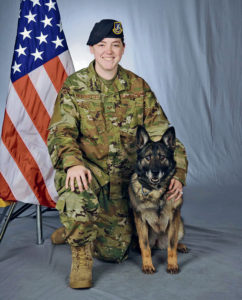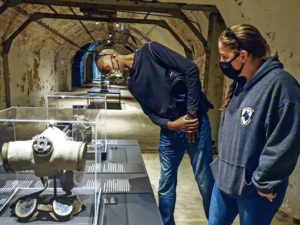
Military working dog trainers honored heroes of past conflicts, including animals who carried out critical missions in service to their countries, at former U.S. Army Ordnance Depot Maßweiler, Sept. 4.
To honor animals’ service during various wars, an animal welfare organization opened an exhibit called “Animals in War and Peace,” in the former U.S. Army Ordnance Depot Maßweiler. The bunker, in which the exhibit was built, previously housed U.S. military ammunition and then returned it to German control in the 1990s. The animal welfare organization purchased the property in 2000, then transformed it into the exhibit.
“The exhibit doesn’t only tell the story of animals during times of war, it also tells the story of the bunker,” said Florian Eiserlo, site manager and biologist. “It was built by the Germans during World War II and then was used by the U.S. Army – the bunker is part of the history of both countries. We still have several U.S. [military] facilities in the surrounding areas, so the connection continues to this day.”
The exhibit showcased various animals involved in war. Animals such as bees, dolphins, pigs, bats, elephants, horses and pigeons served their respective countries.
Two military working dog trainers from the 86th Security Forces Squadron seized the opportunity to build upon the German and U.S. relationship by attending the exhibit’s opening ceremony to honor the contributions and sacrifices of various animals throughout wars.
“Being a military working dog handler provides the military the ability to detect substances that are otherwise undetectable,” said U.S. Air Force Staff Sgt. Lisa Kiesewetter, 86th Security Forces Squadron military working dog trainer. “They also provide a psychological deterrence as well as being a force multiplier.”

The mission of military working dogs along with their handlers is vital to protecting military assets and personnel. Handlers train canines to sniff out drugs and explosives. If a dog detects the scent of these items, they will alert their handler.
“Animals play an important role in times of war,” Eiserlo added. “They defended their humans, and gave them companionship and comfort during difficult times. In doing so, they changed history. Animals are often forgotten when we talk about casualties of war. These stories honor the heroic acts of these animals.”
Military working dogs have been of service to the United States for more than 100 years. They served as scouts for patrols, messengers and sentries.
“It is important to honor animals who have served in conflict, as they provide abilities that humans do not possess and have not been able to replicate,” Kiesewetter added. “These animals serve their country, just like their human counterparts.”
As a 15-year veteran, Kiesewetter has deployed four times supporting missions in Kuwait, Afghanistan, Turkey and Kenya.
“This event meant a lot to me as it ties my family’s German heritage of my service to the U.S. Air Force and our NATO allies,” Kiesewetter explained.
In the final moments, the animal welfare organization thanked the military working dog trainers for supporting the event.
“It is a great honor to have military working dog trainers attend this ceremony,” Eiserlo said.


